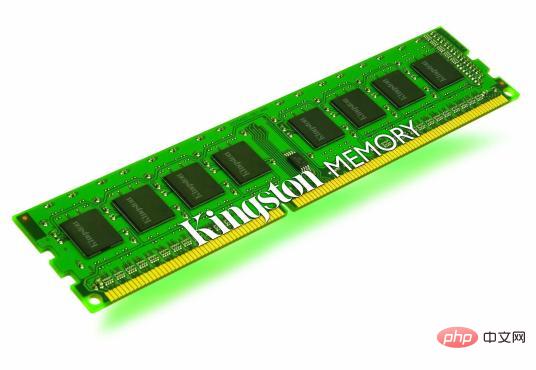
dram is a memory stick. DRAM means "Dynamic Random Access Memory" in Chinese. One of its main characteristics is that data will be lost after power is cut off. This is what is usually called memory. A transistor and a capacitor are usually used to represent a bit. DRAM has a very high density, a high capacity per unit volume and therefore a low cost; DRAM also has the disadvantages of slow access speed and high power consumption.

The operating environment of this tutorial: Windows 7 system, Dell G3 computer.
dram is a memory stick.
Memory stick overview
Memory stick is a channel connecting the CPU and other devices, which plays a role in buffering and data exchange. When the CPU is working, it needs to read data from external storage such as the hard disk. However, because the "warehouse" of the hard disk is too large and far away from the CPU, the speed of transporting "raw material" data is relatively slow, causing the CPU to The production efficiency is greatly reduced! In order to solve this problem, people built a "small warehouse" - memory between the CPU and the external memory.
Function of memory stick
Memory is the main component in the computer, which is relative to external memory. The programs we usually use, such as Windows 7 system, typing software, game software, etc., are generally installed on external memory such as hard disks, but their functions cannot be used only by this. They must be transferred into the memory to run. Using its function, we usually input a piece of text or play a game, which is actually done in memory. Usually we store a large amount of data that we want to save permanently in external memory, and put some temporary or small amounts of data and programs in memory.
Classification of memory sticks
Memory is divided into two types: DRAM and ROM. The former is also called dynamic random access memory. One of its main characteristics is that it breaks Data will be lost after power-on. This is what we usually call memory; the latter is also called read-only memory. When we turn on the computer, the first thing we start is the BIOS program stored in the ROM on the motherboard, and then it calls the BIOS program in the hard disk. For Windows, one of the main features of ROM is that data will not be lost after a power outage.
According to the number of pins on the memory stick, we can divide the memory stick into 30 lines, 72 lines, 168 lines, etc. 30-line and 72-line memory modules are also called single-rank memory modules (SIMM). (SIMM is a memory structure with gold fingers on both sides providing the same signal.) 168-line memory modules are also called dual-rank memory modules DIMM. At present, 30-line memory modules are no longer available; the popular variety in the past few years was 72-line memory modules, with capacities generally ranging from 4 MB, 8 MB, 16 MB, and 32 MB; the current mainstream variety in the market is 168-line memory 168-line memory sticks generally have capacities of 16 MB, 32 MB, 64 MB, 128 MB, etc. A general computer will be fine just plugging one in. However, only motherboards based on VX, TX, and BX chipsets support 168 lines of memory.
According to the working mode of memory, memory can be divided into FPA EDO DRAM and SDRAM (synchronous dynamic RAM).
FPM(FAST PAGE MODE)RAM
Fast page mode random access memory: This is the memory commonly used by earlier computer systems. It is every three Data is transferred once per clock pulse cycle.
EDO(EXTENDED DATA OUT)RAM
Extended data output random access memory: EDO memory cancels the time interval between the two storage cycles of the motherboard and the memory. It outputs data once every two clock pulse cycles, greatly shortening the access time and increasing the storage speed by 30%. EDO is generally 72 pins, and EDO memory has been replaced by SDRAM.
S(SYSNECRONOUS)DRAM
Synchronous dynamic random access memory: SDRAM is 168 pins, which is the memory currently used by PENTIUM and above models. SDRAM locks the CPU and RAM together through the same clock, allowing the CPU and RAM to share a clock cycle and work synchronously at the same speed. The rising edge of each clock pulse starts transmitting data, which is 50% faster than EDO memory. .
DDR (DOUBLE DATA RAGE) RAM
An updated product of SDRAM, it allows data to be transmitted on the rising and falling edges of the clock pulse, so there is no need to increase the clock The frequency can double the speed of SDRAM.
RDRAM(RAMBUS DRAM)
Memory bus type dynamic random access memory. RDRAM is a new type of DRAM developed by RAMBUS Company with system bandwidth and chip-to-chip interface design. It can transmit data through a simple bus in a very high frequency range. It also uses low-voltage signals to transmit data on both edges of high-speed synchronization clock pulses. INTEL will add support for RDRAM to its 820 chipset products.

##DRAM (Dynamic Random Access Memory)
DRAM (Dynamic Random Access Memory, dynamic random access memory), the most commonly used type of computer memory. It usually uses a transistor and a capacitor to represent a bit. Unlike firmware memories such as ROM and PROM, the two main types of random access memory (dynamic and static) will lose their stored data when the power is turned off.
DRAM is a kind of semiconductor memory. Its main working principle is to use the amount of charge stored in the capacitor to represent whether a binary bit (bit) is 1 or 0. Since transistors have leakage current in reality, the amount of charge stored on the capacitor is not enough to correctly determine the data, resulting in data corruption. Therefore, periodic charging is an unavoidable requirement for DRAM. Because of this characteristic that requires periodic refresh, it is called "dynamic" memory. Relatively speaking, as long as static memory (SRAM) stores data, the memory will not be lost even if it is not refreshed.
Compared with SRAM, the advantage of DRAM is its simple structure - each bit of data only needs one capacitor and one transistor to process, compared to SRAM, which usually requires six transistors per bit. For this reason, DRAM has a very high density, a high capacity per unit volume and therefore a low cost. But on the contrary, DRAM also has the disadvantages of slow access speed and high power consumption.
Like most random access memories (RAM), DRAM is a volatile memory device because the data stored in it will disappear soon after the power is cut off.
For more related knowledge, please visit the FAQ column!
The above is the detailed content of Is dram a memory stick?. For more information, please follow other related articles on the PHP Chinese website!
 Is the speed of php8.0 improved?
Is the speed of php8.0 improved?
 What does ps mask mean?
What does ps mask mean?
 Velocity syntax introduction
Velocity syntax introduction
 How to restore Bluetooth headset to binaural mode
How to restore Bluetooth headset to binaural mode
 How is the performance of thinkphp?
How is the performance of thinkphp?
 what is world wide web
what is world wide web
 Win11 My Computer Added to Desktop Tutorial
Win11 My Computer Added to Desktop Tutorial
 What is the difference between hardware firewall and software firewall
What is the difference between hardware firewall and software firewall